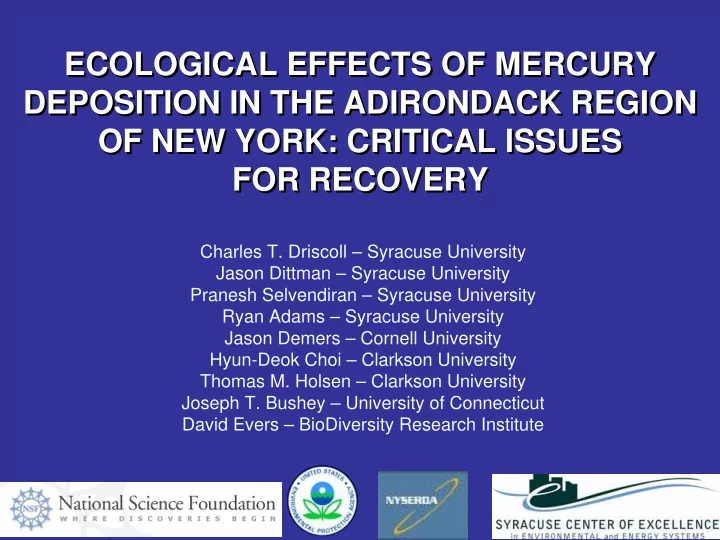

ECOLOGICAL EFFECTS OF MERCURY ECOLOGICAL EFFECTS OF MERCURY DEPOSITION IN THE ADIRONDACK REGION DEPOSITION IN THE ADIRONDACK REGION OF NEW YORK: CRITICAL ISSUES OF NEW YORK: CRITICAL ISSUES FOR RECOVERY FOR RECOVERY Charles T. Driscoll – Syracuse University Jason Dittman – Syracuse University Pranesh Selvendiran – Syracuse University Ryan Adams – Syracuse University Jason Demers – Cornell University Hyun-Deok Choi – Clarkson University Thomas M. Holsen – Clarkson University Joseph T. Bushey – University of Connecticut David Evers – BioDiversity Research Institute
Outline Outline • The State of Mercury Contamination - Biological Mercury Hotspots • What is the Path to Recovery? - Watershed Mercury Cycling - Recent Trends in Mercury in Water and Fish • Key Findings and Questions
Northeastern Ecosystem Research Northeastern Ecosystem Research Cooperative (NERC) - Hg Cooperative (NERC) - Hg • 2002 - 2005 • ~70 research scientists • Data – Surface waters - 831 sites – Surface sediments - 579 sites – Sediment cores - 37 lakes – Fish - 15,305 fish tissue – Wildlife – 5,600 tissue
Study Region and Mercury Datasets Evers 2005. Mercury Connections.
Methods Methods 1. Based on 7,311 observations 2. Human health analysis: - Indicator = yellow perch - Threshold = 0.3 ppm (EPA level) 3. Ecological health analysis - Indicator = Common loon blood - Threshold = 3.0 ppm
Biological Mercury Hotspots Biological Mercury Hotspots Global and Regional Atmospheric Emissions and Deposition Reservoir Fluctuations Local Emissions Landscape Sensitivity
Biological Hotspots Can Be Caused by Moderate Mercury Deposition to Sensitive Watersheds Sensitive Watersheds: 1. Abundant forest cover and wetlands 2. Shallow groundwater flow paths 3. Low nutrient inputs 4. Impacted by acid rain
140 120 Regional Hg T Emissions 100 (T y -1 ) 80 60 40 20 Recent Declin Recent Declines es 0 14 Increases d creases due t e to in increases creases Back Background ound Level Levels 12 (ug m -2 y -1 ) in h in human emiss man emissions and ons and Little Echo Hg T Flux 10 de deposi sition 8 6 4 2 0 1800 1810 1820 1830 1840 1850 1860 1870 1880 1890 1900 1910 1920 1930 1940 1950 1960 1970 1980 1990 2000 Year Number 39 ~ 3 ug/m 2 -yr Background Increases start ~ 1880 - 1900 Peak ~ 1970 - 1990 Peak/Background ~ 5.6 (2.4 - 13.8) % Reduction from peak ~ 30 (0 - 71)%
Arbutus Lake – 48.2 ha Arbutus Lake – 48.2 ha
Arbutus Lake Watershed-352 ha Arbutus Lake Watershed-352 ha
5.9 Hg T Flux 14.8 (µg/m 2 *yr) 5.8 Hg T Pool 5.4 (µg/m 2 ) 0.4 1.4 5.1 9,060 1.1 1.0 1.2 63,900 2.4 25,100 0.8
MeHg Flux (µg/m 2 *yr) 0.04 0.032 0.032 63 0.019 0.04 231 0.096 0.020
# # # # # ## # # # # # # # # # # # ### # # # #
7.5 7.0 6.5 pH 2005-06 6.0 5.5 5.0 4.5 4.5 5.0 5.5 6.0 6.5 7.0 7.5 pH 1992-93 80 -2 ( μ mol L-1) 2005-06 60 40 20 SO4 0 0 20 40 60 80 SO4-2 ( μ mol L-1) 1992-93
1.2 1992-93 1.0 2005-06 0.8 MeHg ng L-1 0.6 0.4 0.2 0.0 8 1992-93 7 2005-06 6 5 THg ng L-1 4 3 2 1 0 0 5 10 15 20 25 DOC mg C L-1
8.0 7.0 Total Hg (ng L-1) 2005-06 6.0 5.0 4.0 3.0 2.0 1.0 0.0 0.0 1.0 2.0 3.0 4.0 5.0 6.0 7.0 8.0 Total Hg (ng L-1) 1992-93 1.0 MeHg (ng L-1) 2005-06 0.8 0.6 0.4 0.2 0.0 0.0 0.2 0.4 0.6 0.8 1.0 MeHg (ng L-1) 1992-93
0.9 1992-93 0.8 2005-06 Mean fish Hg ( μ g g -1 ) 0.7 0.6 0.5 0.4 0.3 0.2 0 1 2 3 4 5 6 7 8 9 10 Fish Age
Key Messages Key Messages • Comprehensive analysis of air, sediment, water, fish and wildlife show that Hg contamination is pervasive. • Five biological Hg hotspots and nine additional areas of concern are identified in the Northeast that pose ecological and human health risk • Mercury inputs to forest ecosystems largely occur by litterfall. Soil and lake sediments are a sink for Hg inputs. Wetlands are the major source of methyl Hg. • There have been recent decreases in Hg loading, generally decreases in water column Hg and some decreases in fish Hg. • Environmental monitoring programs are needed to fully document the extent and changes in Hg pollution.
Critical Questions Critical Questions • What is the fate of atmospherically deposited Hg, particularly from litter and in soil? • Do Hg concentrations in fish decrease in response to decreases in Hg loading and what factors affect this response (e.g., sulfate load, changes in DOC, watershed characteristics)? • What levels of emission controls will be adequate to reduce Hg exposure to acceptable levels?
Recommend
More recommend